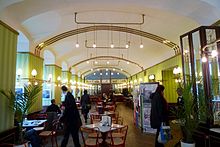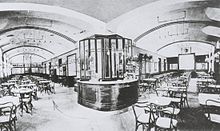Café Museum


The Café Museum is a coffee house in Operngasse 7 in Vienna's 1st district, Innere Stadt , which opened in 1899 and quickly became a meeting place for Viennese artists. The original interior was designed by Adolf Loos .
history
architect
The corner building at Friedrichstrasse / Operngasse was built in 1872 according to plans by the architect Otto Thienemann . In 1899 , Max Fabiani , architect of Urania , was commissioned by the owner of the coffee house to set up a new restaurant on the corner of Friedrichstrasse and Operngasse. But Fabiani selflessly convinced the coffeehouse owner that the young Adolf Loos, who until then had worked almost exclusively as an art critic, could best fulfill this task. In doing so, Fabiani brokered the architect Adolf Loos' first important commission: the establishment of the Café Museum.
Concept and equipment
Adolf Loos was of the opinion that an architect should limit himself to the functional and that attempts at artistic design on objects of daily use were inappropriate. He therefore designed the Café Museum with a decidedly simple design, which was considered revolutionary when it opened. He needed smooth walls, brass strips, marble tables with wooden feet, bentwood and wicker chairs, incandescent lamp sockets on electric wires with incandescent lamps (without lampshades), tubes that could be used as gas pipes for his café furnishings, which he used to orient himself towards the Biedermeier coffee houses They were also used as clothes rails, mirrors to enlarge the room and framed prints by the American artist Charles Dana Gibson for the so-called "Gibson Room". With the establishment of the "Gibson Room" in the Café Museum, Loos clearly demonstrated his fondness for America. A few years later he renewed the evidence of this weakness by furnishing the “American Bar” in the Carinthian passage.
With a marble table and bentwood chair, Adolf Loos propagated classic furnishings for the coffee houses of the 20th century in the last year of the 19th century. The “Café Museum” served as a binding model not only for coffee houses, but also for all modern interiors of the subsequent epochs. The use of the straight, unturned billiard table legs, which in turn were based on the billiard table legs of the Biedermeier, had a lasting effect on the grand piano legs, which were made straight and unturned from then on.
Naming
Ludwig Frisch, the first café animal in the “Café Museum”, previously ran a “Café zum Museum” in Babenbergerstraße 5 behind the Kunsthistorisches Museum and transferred the old name to his new restaurant on Friedrichstraße in a somewhat simplified manner. In the vicinity of the new restaurant there was no longer a museum with old works of art, on the contrary: Not far from there was Vienna's most modern and provocative exhibition hall: the Vienna Secession .
Nickname
Soon after the pub opened in spring 1899 , the artists of the Secession building, which opened on November 12 of the previous year, discovered the Café Museum as their meeting place. For this reason, the café was soon dubbed “Secessionist Czechs”, somewhat unjustifiably and pejoratively. In a sense, the result was a stair joke in art and cultural history: A declared opponent of the Secessionists, Adolf Loos , had set up their favorite bar.
Regular guests
The café's regulars in the early 20th century included Peter Altenberg , Alban Berg , Hermann Broch , Elias Canetti , Gustav Klimt , Oskar Kokoschka , Karl Kraus , Franz Lehár , Adolf Loos , Robert Musil , Joseph Maria Olbrich , Leo Perutz , Joseph Roth , Roda Roda , Egon Schiele , Georg Trakl , Otto Wagner and Franz Werfel . Later the writers Albert Paris Gütersloh , Ernst Jandl and Friederike Mayröcker were regular guests.
Remodeling
The interior architect from Tyrol and chief designer of the “Prag Rudniker Korbwaren-Fabrikation” Josef Zotti , a student of the architect Josef-Hoffmann , was commissioned in 1914 to design a basket balustrade around the street seats of the Café Museum in Friedrichstraße. From 1930 to 1931 he redesigned the café profoundly. He installed semicircular seating boxes made of red artificial leather along the walls and thus created a cozy living room character, which was in contrast to the previously cool interior. An extra room with a large mirror, which was not furnished with benches, but only with chairs and tables, acted as a magnet for local and international chess players until the 1990s.
In 2003 the Café Museum was rebuilt based on the original Loos design. Parts of the original Zotti furnishings were taken over in the course of the renovation in the Vienna Imperial Furniture Collection . The Loos reconstruction was criticized on the one hand because of the lack of authenticity and on the other hand because of the less comfortable seating. Regarding the redesign in 2003 with the implementation of the restored Loos furniture (and the associated increase in prices), the “Wiener Zeitung” columnist Johann Werfring noted in retrospect in 2012: “From the Café Museum on Karlsplatz (...) one has in In 2003, together with the Zotti furniture from the 1930s, the student and (life) artistic customers were also complimented. ”After the renovation, there was no more space for the chess players. The Café Museum was closed at the end of 2009.
After the Viennese restaurateur Berndt Querfeld took over the coffee house, it was rebuilt again. Since the replica of the Loos facility was perceived as unsuccessful, the architect Hans Peter Schwarz once again turned to Josef Zotti for the redesign: The upholstered semicircular benches are reconstructions, which, however, do not have a red color like in the original Zotti design Imitation leather, but are equipped with red velvet covers. Based on the original Zotti interior, reconstructed metal ball lamps made of chrome- nickel steel, in which the interior of the coffee house are reflected, were installed. The light sources of the lamps are located in the spheres, which are open at the top. The light is reflected into the rooms by the hemispheres attached to the ceiling. On October 18, 2010, the Café Museum was reopened after Querfeld had been redesigned. When it reopened, the new owners announced that the old chess tradition would be reconnected in the Café Museum, but this was ultimately not implemented. Today there is room for 207 guests in the Café Museum.
Coffee house readings
Coffee house readings have been taking place regularly in the Café Museum since October 2011. The writers who have held readings in the café since then include Daniel Glattauer , Christine Nöstlinger , Franzobel , Lisa Lercher , Armin Thurnher , Susanne Scholl , Gerhard Loibelsberger and Elfriede Hammerl .
Individual evidence
- ↑ Otto Thienemann. In: Architects Lexicon Vienna 1770–1945. Published by the Architekturzentrum Wien . Vienna 2007.
- ^ Architectural dictionary : Adolf Loos. Retrieved November 12, 2014 .
- ↑ Hans Haider: Das Literatencafé Article on austrians.org.
- ^ Café Museum in the Vienna History Wiki of the City of Vienna
- ↑ Bernhard Lichtenberger: Vienna: Landtmann boss takes over Café Museum article in the daily newspaper "Die Presse", online version from 7 July 2010.
- ^ Johann Werfring: The last Alt-Wiener Schachcafé article in the "Wiener Zeitung", online version from March 26, 2001.
- ^ Johann Werfring: The renaissance of the thinking sport . In: “Wiener Zeitung” of February 14, 2009, supplement “Extra”, p. 8.
- ↑ Christian Kühn: Café Gespenst Article in the daily newspaper “Die Presse” from January 3, 2004, supplement “spectrum”, p. IX.
- ^ Johann Werfring: Café Museum museal Article in the "Wiener Zeitung" of February 5, 2009, supplement "ProgrammPunkte", p. 7.
- ^ Johann Werfring: Old Viennese refuge for night owls Article in the "Wiener Zeitung" of October 4, 2012, supplement "ProgrammPunkte", p. 7.
- ↑ a b Plüsch reloaded: The Vienna Cafe Museum has reopened. Kleine Zeitung , online version October 18, 2010, accessed March 20, 2015 .
- ^ Café Museum - Radical conversion for a classic Viennese coffee house . In: Solid - Wirtschaft und Technik am Bau (industry magazine), February 4, 2010.
- ↑ New start for Cafe Museum , article on wien.orf.at , July 7, 2010.
- ↑ Cafe Museum in a new look. In: wien.orf.at of October 18, 2010. Accessed January 5, 2015 .
- ↑ ANNIVERSARY! We are celebrating 1 year of literature in the Café Museum. Anniversary reading! (No longer available online.) Archived from the original on November 12, 2014 ; Retrieved November 12, 2014 . Info: The archive link was inserted automatically and has not yet been checked. Please check the original and archive link according to the instructions and then remove this notice.
- ^ Literature in the Café Museum. Retrieved November 12, 2014 .
literature
- Peter Altenberg, Charles Dana: Gibson Album . In: "Wiener Allgemeine Zeitung", Vienna, January 1, 1899, p. 4.
- Anonymous: The new Café Museum . In: “Neues Wiener Journal”, Vienna, April 19, 1899, p. 5.
- Ludwig Hevesi, art on the street . In: "Fremdblatt", Vienna, May 30, 1899, p. 13 f.
- Ludwig Hevesi, Modern Coffee Houses . In: "Art and Crafts", 2nd year, Vienna 1899, p. 196 ff.
- Heinrich Kulka, Adolf Loos. The work of the architect , Vienna 1931, p. 27 f., Fig. 7 u. 8th.
- Burkhardt Rukschcio and Roland Schachel: Adolf Loos: Life and Work , Salzburg 1982.
- Elias Canetti: The eye game. Life story 1931–1937 , Munich and Vienna 1985, pp. 123–126 (“Silence in the Café Museum”).
- Roberto Festi: Josef Zotti architetto e designer 1882–1953 , catalog of the exhibition in Trento, Palazzo delle Albere (December 18, 1993 to February 6, 1994) and in Vienna, Heiligenkreuzerhof (May 5 to June 11, 1994), p. 146 and p. 175f.
- Day Gronberg: Coffeehouse Encounters: Adolf Loos's Café Museum . In: Tag Gronberg, Vienna. City of Modernity, 1890–1914, Bern 2007, pp. 69–96.
- Andrea Portenkirchner: The loneliness at the "window seat" to the world. The literary coffee house in Vienna 1890–1950 . In: Michael Rössner (Ed.): Literary Coffee Houses, Coffee House Literature, Böhlau Verlag, Vienna, Cologne and Weimar 1999, p. 41f.
- Johann Werfring: Café Museum alias Café Nihilism Article in the “Wiener Zeitung”, online version from March 19, 2001.
- Johann Werfring: Café Museum museal Article in the “Wiener Zeitung” of February 5, 2009, supplement “ProgrammPunkte”, p. 7.
- Christian Kühn: Café Gespenst Article in the daily newspaper “Die Presse” from January 3, 2004, supplement “spectrum”, p. IX.
- Florian Holzer: The re-deconstruction article in "Falter" No. 42/2010 from October 20, 2010.
- Café Museum is 110 article from March 31, 2009 in the daily newspaper "Der Standard".
- Hans Veigl : Viennese coffee house manager . Kremayr and Scheriau, Vienna 1994, ISBN 978-3-218-00587-6 .
- Bartel F. Sinhuber: A guest in old Vienna. Memories of hotels, taverns and coffee houses, beer cellars, wine bars and excursion restaurants . Amalthea, Vienna 1997, ISBN 3-85002-409-1 .
- Catalog for the special exhibition of the Historisches Museum der Stadt Wien 93, p. 438f.
Web links
- Website of the Café Museum
- Café Museum website from 2003 to 2009 (Loos reconstruction) ( Memento from June 2, 2008 in the Internet Archive )
- Café Museum in the Vienna History Wiki of the City of Vienna
- Ute Woltron: A Loos forgery . The converted Café Museum. ORF , Ö1 , Diagonal - radio for contemporaries , about Adolf Loos. February 16, 2008.
- soma-morgenstern.at - Café Museum (PDF file; 624 kB)
- Café Museum on Stadtknown.at
- Café Museum open again Short film (2010) on puls4.com.
- The original interior design designed by Loos on habsburger.net of the Schönbrunn Palace culture and operating company
Coordinates: 48 ° 12 ′ 4 ″ N , 16 ° 22 ′ 2 ″ E






